Chasing memories inside Silicon Valley’s Desi grocery stores
This article was produced as a project for the USC Annenberg Center for Health Journalism’s 2021 California Fellowship.
Other Stories by Srishti Prabha includes,
Endurance Test: Underserved Desi Grocery Workers Go to the Front Lines
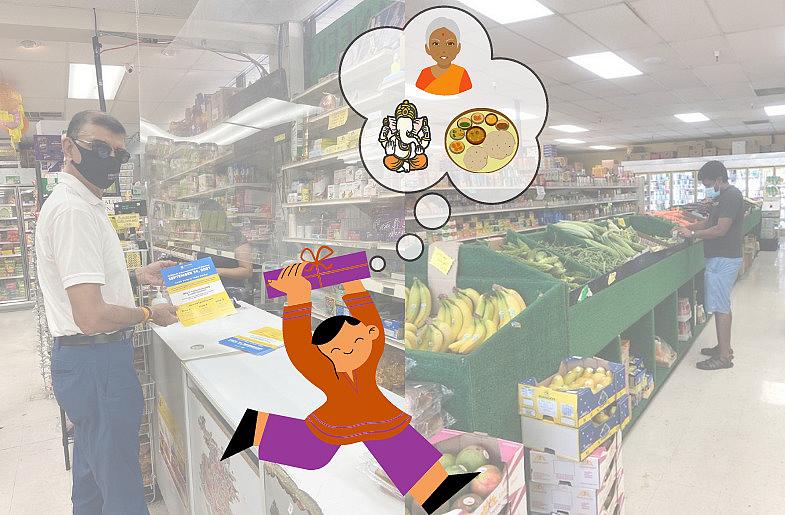
At New India Bazaar in Evergreen, CA.
Masala Heroes is a three-part series on Santa Clara County’s South Asian (Desi) grocery stores and their contribution to their community’s health. This first article provides a resource map of all the Desi grocery stores and Desi restaurants of Santa Clara County in 2021.
I’m exhausted after my Kathak dance class but Ma is determined to finish her errands at Kumud Groceries, the Desi store which is now Trinethra on Pearl Avenue. She needs lauki (calabash), karela (bitter gourd), and dhaniya (cilantro) to cook for the week. I try to haggle. “Leave me at home and then go to Safeway. It’s two minutes from our house,” I whine. I’m tired and I don’t want to be seen wearing my Kathak kurtha. Ma tries to bribe me with Falooda and samosas. “You know that I can’t get everything I need at Safeway,” she says. Finally, she promises that I can pick out the Bollywood DVD rental for our family movie night. We strike a deal.
Perched at the intersection of Pearl Avenue and Branham Lane, Trinethra is the quintessential Desi (ethnic) grocery store that emblemizes the sights, sounds, scents, and feelings of South Asia. The bustle inside is reminiscent of the corner bazaar with densely packed vegetables, packets of Kurkure hanging from walls, Parle-G biscuits to pair with chai, and the constant chitter-chatter in some South Asian dialect that, even if you don’t understand, has an intimate warmth. Bay Area immigrants gravitate to their local Desi grocery store to find items essential to their ethnic diet, but they leave with more than just the items in their shopping cart.
Asha Panday does almost all her shopping online, except for when she makes the long drive to the India Cash and Carry in Sunnyvale. “I go because I want to feel the vegetables, smell the spices, and look at all the stuff. [It] gives me the feeling of being back in India. I used to live in the Santa Cruz mountains and made the 50-mile trip every month. Now I live in San Francisco and still make the 50-mile trip.”
Touching the methi (fenugreek leaves), smelling fragrant MTR spice blends, spotting the familiar Desi face on the Vatika coconut hair-oil bottles — these are the things that provide Panday, and other Desi immigrants, with a sense of solace and belonging, which is invaluable to Desi mental and cultural health.
When Susheela Narayan visits her local Desi grocery store, she’s taken back to the times spent with her father. “The combination of fresh Indian vegetables neatly stacked up and the ubiquitous smell of different spices that pervades the store takes me back 50 years to memories of going to the Indian bazaars of my youth with my father. It’s oddly comforting, especially during the pandemic.”
During the COVID-19 pandemic, a time when South Asian immigrants were separated from their families — some fell ill and many had to grieve in isolation — the 24 Desi grocery stores in Santa Clara County were lifelines to familial memories and home. These Desi grocery stores have continued to serve a population of 1.7 million people, of which 6.6% (112,200) are Indian (2010 census data doesn’t specify other South Asian demographics). Desi grocery stores, small but mighty, are imperative as mediums for diasporic cultural knowledge and diet, for a heterogeneous and robust Desi culture, and for the proliferation of other Desi businesses. Time and time again, we see cultural dilution as a consequence of assimilation. The variety and the sheer number of Desi grocery stores in Santa Clara County are unique, recent, and fragile. These stores are the heroes of the South Bay Desi community, actualizing the very identities that define the people accessing them. South Asians and others alike must sustain these businesses as a means for cultural preservation.
Srishti Prabha outside of Kamal Spice House in South San Jose.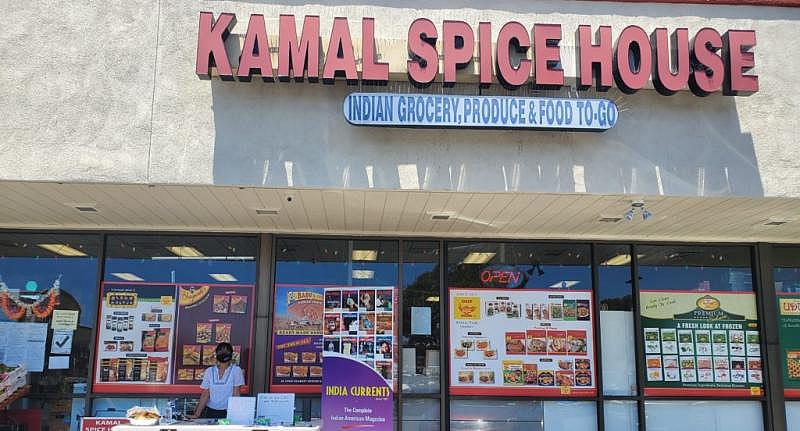
After the 1924 Asian Exclusion Act was reversed and the Immigration and Nationality Act of 1965 was passed, South Asians on H1B visas moved into the hills of Silicon Valley. As a new immigrant base in California, they were subjected to inequitable access to ethnic food and an undercurrent of American xenophobia. Many assimilated and ethnic foods were replaced by food seen as “western”, thus more acceptable. Restrictive immigration policies only allowed for those with ‘highly specialized knowledge and a ‘college degree’ to enter and work in the U.S. under the H1B visa. Devoid of recognizable language, family, and culture, Desi immigrants sought comfort and belonging. It was this desire to grasp at the cultural ties from which the nascent Desi food culture was born. Food was the vehicle to keep a part of their culture in a foreign land and the Desi grocery store was a means to that end.
“It felt like home a little bit. It had the same ingredients…the same things you put in your stomach, the same aromas, and you even hear familiar dialects in the background.” Hardeep Setia fondly remembers his visits to Singh’s Video, a grocery store in San Jose that has long since shut down. Setia’s piquant reflection distinctly calls upon the feeling of community, one of many whispered tales that are shelved within the aisles of the ethnic grocery store. A first-generation Punjabi-Gujarati American, Setia has lived in San Jose since he was seven years old and frequents the Desi grocery stores that are sprinkled throughout the South Bay.
Inside the Desi Grocery Store
“Food becomes the symbol of a people,” says Dr. Lok Siu, a Professor of Ethnic Studies at the University of California Berkeley who studies the correlation between culture and food. The tangential use of misinformed terminology like “curry” and the constant reduction of Indian food to “Chicken Tikka Masala” propagates stereotyping of a multi-lingual, multi-religious, multi-faceted, centuries-old culture. Dr. Siu poignantly reminds us that, “Food becomes a way of articulating distance, othering, and discrimination.”
As recently as August 19, 2021, Gene Weingarten’s Washington Post opinion article disparagingly referred to Indian food as food that “you can’t make me eat,” inaccurately stating that it was an entire cuisine based on one spice (a statement that was later retracted) — an egregious misstep he wouldn’t have made had he entered a Desi grocery store even once.
Even before setting foot in Kamal Spice House in San Jose, images of a variety of DEEP’s products, frozen samosas, pickles, and spices, decorate the windows. The DEEP overplayed commercial catchphrase — “Khao to jaano” (only if you eat, you’ll know) — comes to mind. Crates of Alphonso mangoes, a Desi favorite, and local newspapers (India-West) greet shoppers at the door.
Once inside, to the right, fresh produce is available in abundance at low prices. It’s common to see shoppers feel the rough, green bhindi (okra), placing those deemed suitably supple, in their carts. The keen Desi eye scans for vegetables and fruits that are elusive in non-Desi supermarkets — baingan (Indian eggplant), parwal (pointed gourd), haree mirch (green chili), moringa (drumstick), nariyal (coconut), sem (green beans), dhaniya (coriander/cilantro), tindora (scarlet gourd), and more. Against the wall, an overwhelming selection of 10-pound bags with brown rice, basmati rice, long-grain rice, and jasmine rice are stacked against the wall.
For those unsure of what to cook, how to cook, or short on time, frozen goods — parathas, naans, pre-made meals — are in the first aisle for a quick stop shop. Fridges line most of the back perimeter with more pre-made meals, halal meats, paneer, dosa and idli batter, sweets, and other dairy products.
The spice aisle at Kamal Spice House in South San Jose.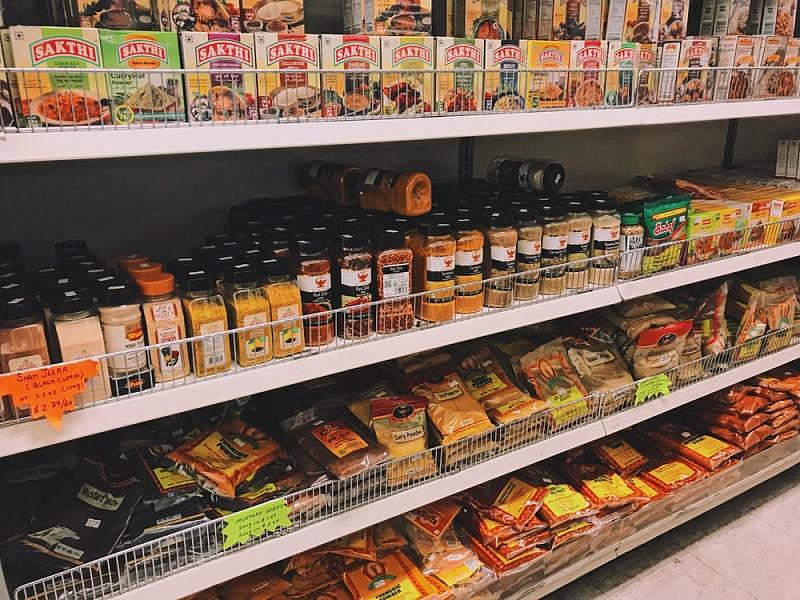
One side of an aisle is mainly spices – jeera (cumin), haldi (turmeric), kashmiri mirch, lal mirch (red chili), chaat masalas, mustard seeds, cumin seeds, curry pathas (curry leaf), panch phoran (five spices), and more. Another side of an aisle is for the many dried dals – moong, kabuli chana, masoor, urad – with a combination of Hindi and English packaging.
And jostling for space within the stores are also different types of chai, biscuits, Haldiram bhujia blends/snacks, oils and ghee, pickles, incense, puja items. Shoppers’ eyes dart back and forth trying to decide between all the options.
An entryway to the left leads to an in-house food stall which emanates with the delicious scents of freshly made pakoras, vadas, and chaat. In classic Desi bazaar fashion, even the space behind the counter is packed with items like oils, shampoos, and other Patanjali products. Desi goods are in every nook and cranny at Kamal Spice House, it’s almost hard to believe you aren’t in India.
San Jose resident Narasimhan Kasthuri puts it best, “The kind of food we eat is available only in our [Desi grocery] stores. Though Costco is selling some of them, our needs are still unmet.” Though big conglomerate supermarkets are convenient and carry some overpriced ethnic goods, they don’t have the imagery, the language, the known embedded in their very blueprint. Kamal Spice House and other Desi grocery stores in Santa Clara County archive memories, generational dietary knowledge, dialect, and cultural practice. Ethnic grocery stores function as thresholds to organic introductions of a cultural minority to neighborhoods.
Nikita, who didn’t want us to include her last name, finds that shopping at Kamal Spice House bridges the 8,200 miles that separate California and India: “Some flavors are linked to childhood memories and comfort. Products from the store allow me to relive that.”
Around the Desi Grocery Store
Flyers on the walls at Trithnethra on Pearl Ave.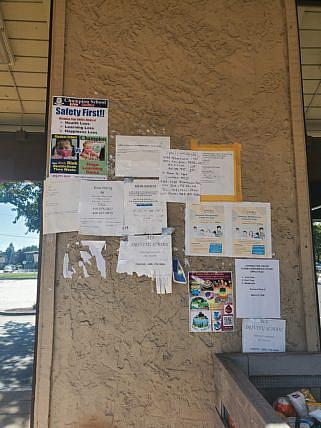
Outer facade of Trinethra on Pearl Ave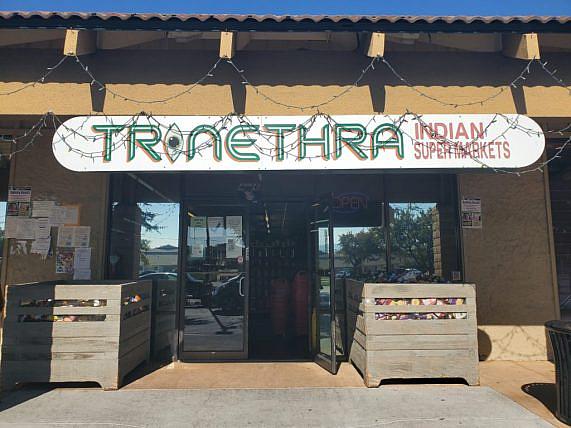
Ali’s Driving School, a room for rent, Shashi’s threading and waxing business are just a few of the flyers that adorn the outer facade of Trinethra in South San Jose. Surrounding Desi businesses in SCC find a space on the walls at the Desi grocery stores. This is a common phenomenon, says Dr. Lok Siu, “[Desi grocery stores] help with the expansion of restaurants and other ethnic businesses.”
Desi grocery stores in five major cities in Santa Clara County – Cupertino, Mountain View, Sunnyvale, Santa Clara, and San Jose – spurred the evolution of other Desi businesses such as restaurants, temples, wedding service providers, clothing, catering, and publications.
“India Currents magazine was always in the corner [of the grocery store] and I remember my dad would pick it up,” Ritika Kumar (25) recalls and smiles — a memory meandering between the spice shelves, a dispersing aroma. “I was 10 and I have this very vivid memory of opening an India Currents magazine and they had interviewed the chef of Amber. I remember that butter chicken recipe!” Kumar’s story is evocative, bringing forth the remnants of a physical print version of India Currents (now fully digital) and the content within it, one which elevated Desi restaurants (Amber – one of the first Indian fine dining restaurants in the Bay Area) and their cuisine.
Creating pipelines for the distribution of South Asian goods and services, Desi grocery stores are the key to burgeoning Desi entrepreneurship and wealth creation. Jasmine Patel, a third-generation Gujarati-American, is part of a household of Desi entrepreneurs. “My grandfather’s brother came in the late 60’s as a student. He and his other brother got jobs as engineers in the U.S. and brought their families. I think at that time non-work-related visas were easier to get. Once family members became citizens, they were able to open businesses. That’s how my family began opening [Indian] warehouses and [Indian] grocery stores in the Bay Area and across the U.S. My aunt was the previous owner of Kumud (now Trinethra in South San Jose) Groceries.”
Just across the Santa Clara County line, Santa Cruz County has just one Desi grocery store, showing how unevenly ethnic grocery stores are distributed. As a graduate student at UC Santa Cruz, Arindam Sarma attempted to replicate his family’s diet. It proved to be a little harder. He comments that “in Santa Cruz, there is exactly one shop in the entire city. It is this tiny one-room shop that has Indian clothes, Indian music, Indian food. It was the only place in the entire city to get spices at a reasonable price. Although I couldn’t always get all items I needed at this store, it was nice to have somewhere to get Indian ingredients.”
The map below indicates the high density of South Asian grocery stores in Santa Clara County and the restaurants surrounding them. Desi grocery stores facilitate a well-rounded, inclusive understanding of the various diasporic differences within the community, as can be deduced from the origins of the cuisine offered in Santa Clara County – Uttar Pradesh, Chettinad, Chennai, Mysore, Punjab, Gujarat, Pakistan, Bengal, Andhra Pradesh. Within the map find locations of active grocery stores with locations, quotes, and transit lines.
Future of the Desi Grocery Stores
India Currents conducted a survey on the significance of Desi grocery stores in Santa Clara County. We received 106 responses from a cross-section of society, 86 of which were from people in Santa Clara County. Despite people talking about how meaningful Desi grocery stores were to them, 69% of South Asians who regularly access the Desi grocery stores responded to the question, “Why is coming to this grocery store meaningful to you?”, with “no story”, “unsure”, “nearby”, or that it had “fresh vegetables.”
Ancestral knowledge of nutrition, health, and cooking practices becomes harder to impart in immigrant communities: partly because of the removal of the individual from a consistent cultural environment where one is inundated with knowledge from aunts, uncles, and neighbors; and partly because of the limited access to ingredients. 95% of people accessing the Desi grocery stores are South Asians in search of traditional vegetables, spices, and snacks. New and old immigrants sustain the ethnic groceries stores with their subconscious cravings for the familiar. However, a glaring discrepancy appears when surveying the Desi grocery stores in SCC — the next generation of Desi Americans appears to be absent. Have the cravings shifted from roti and aloo bhujia to burger and fries?
In-depth interviews with 10 Desi-Americans, ages 25-32, living in the Bay Area, reveal that nine of them intellectually understand the existence of Desi grocery stores as cultural hubs. Their memories are graphic and vivid, communicating a universal childhood experience of seeking spicy snacks, DVDs, and music in these spaces. But eight out ten of them say, they don’t frequent these stores, unless they are running errands for their parents.
Sarma (26), a second-generation Assamese-American, recalls the formative moment in his adult years when he went to Trinethra: “When I was a little older…my mom asked me to go pick up rice. This is the first time I had gone to the store to do a grocery run on my own…So I go to the store and I’m like, rice shouldn’t be too hard to get. In Safeway, there is one area with one type of rice. I go to the [Indian grocery store] and there are walls of rice. Different kinds everywhere. And I think to myself, which rice do I get? There are 50 types. What have I been eating for most of my life?”
Patel (29) relays a similar experience of “being told to go get something and being very lost – not knowing what it looks like. Something ground in a bag?”
Fortunately for Sarma and Patel, a quick call to a parent or a chat with the grocery store employee can solve their problem. These stories expose the crucial role of generational knowledge, the bearers of which are either family members, or those working in the store sourcing the ingredients needed for an ethnic diet. Nine out of the 10 respondents relied on their immediate family for ancestral food-related knowledge.
Radhika Swaminarayan (28), a first-generation Gujarati-American, adds more context to her experience after having lived in places like Seaside, Oregon with little to no access to Desi grocery stores: “Growing up, my family moved a lot. Wherever I lived, [my family] was the only Indian family in the area. It wasn’t until I came to San Jose that I embraced being Indian. I had no one to share those experiences with before .” Swaminarayan finds that, in her experience, the higher density of Desi grocery stores promotes tolerance for ethnic diversity. In San Jose, she feels she can be her most authentic self – wearing madailu (symbolic Gujarati jewelry), eating pau bhaji, and drinking Bournvita (Indian milk supplement) every morning.
All of the first and second-generation Desis said that they would feel a “loss of belonging” if Desi grocery stores were inaccessible. But while the next generation of Desi-Americans intellectualizes the importance of ethnic grocery stores as cultural hubs, they aren’t shopping there. “I do not cook Indian food. I’ll go to the [Desi grocery store] with my mom sometimes but I usually don’t go on my own,” Patel notes. She appreciates how Desi grocery stores are invariably also cultural hubs.
As children of Desi immigrants and their progeny become further removed from the roots of their heritage, the Desi grocery stores in Santa Clara County serve as consistent lifelines to their identities and lineage.
On a recent COVID grocery run to Trinethra, Dimple Ben, the manager, says to me, “Is bar ma ne bheja?” (This time your mom sent you?) She knows that my brother and I have been alternating grocery shifts for our parents. She recognizes me even behind my mask, I feel special. Once inside, I try to make my grocery run quick but that proves to be difficult. I video call my mom to clarify which dal she wants. What used to feel like a chore, now is enjoyable as I pick out items from the Desi grocery store that my stomach desires. Falooda kulfi ice cream goes into my car. My mouth waters at the thought of bhindi bhujia and so in goes the okra. During the pandemic, ma and I have been exploring recipes together, so I try to find the spices for Paneer 65. As I check out, I find comfort in knowing that I always find Dimple Ben and her no-nonsense demeanor at Trinethra. She has seen it all — from my Kathak kurthas and petulant attitude to my first solo grocery store trip and numerous questions. She hands me my groceries and I come to the realization that she is my Masala Hero.
This article was produced as a project for the USC Annenberg Center for Health Journalism’s 2021 California Fellowship.
[This article was originally published by India Currents.]

